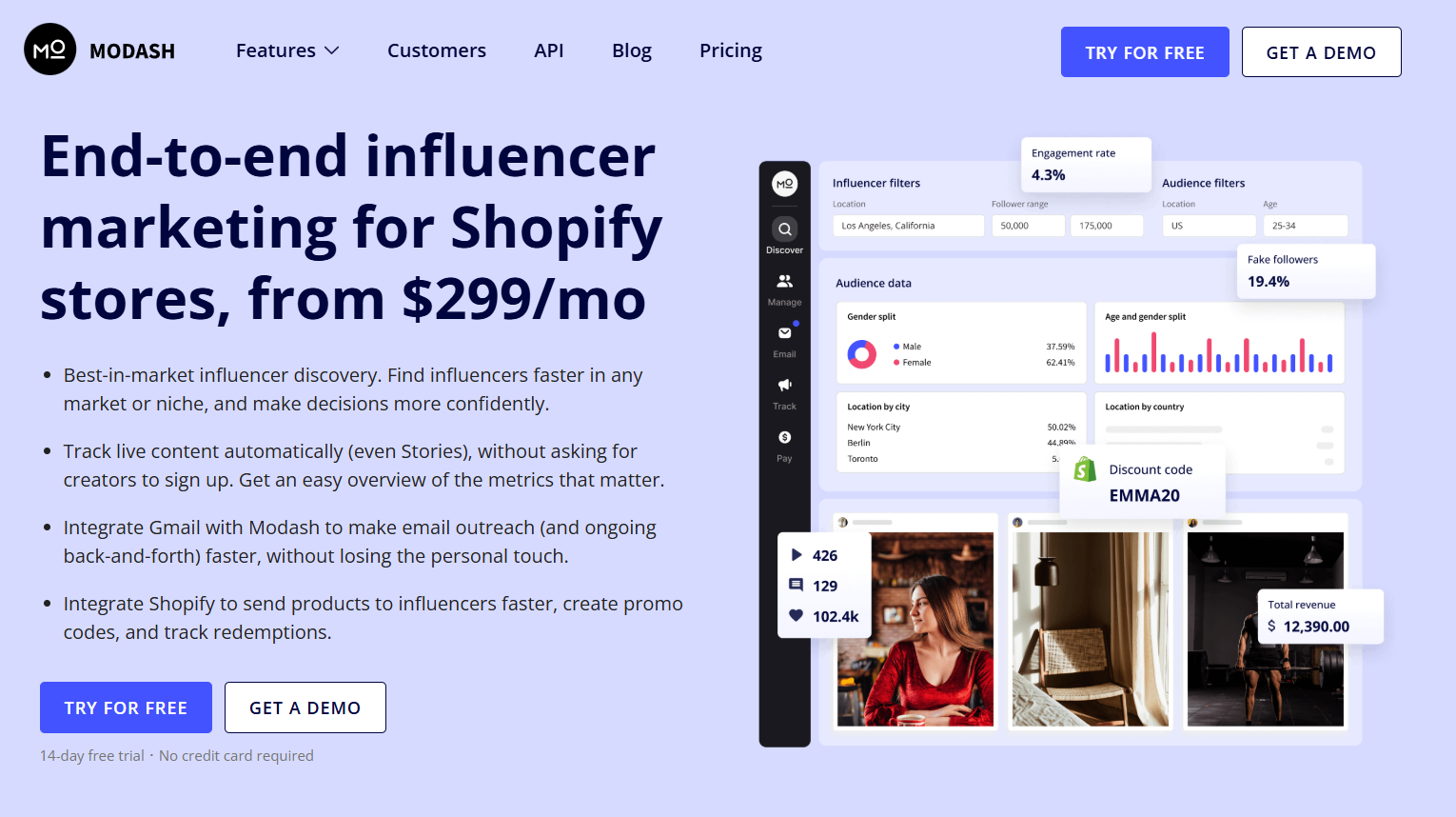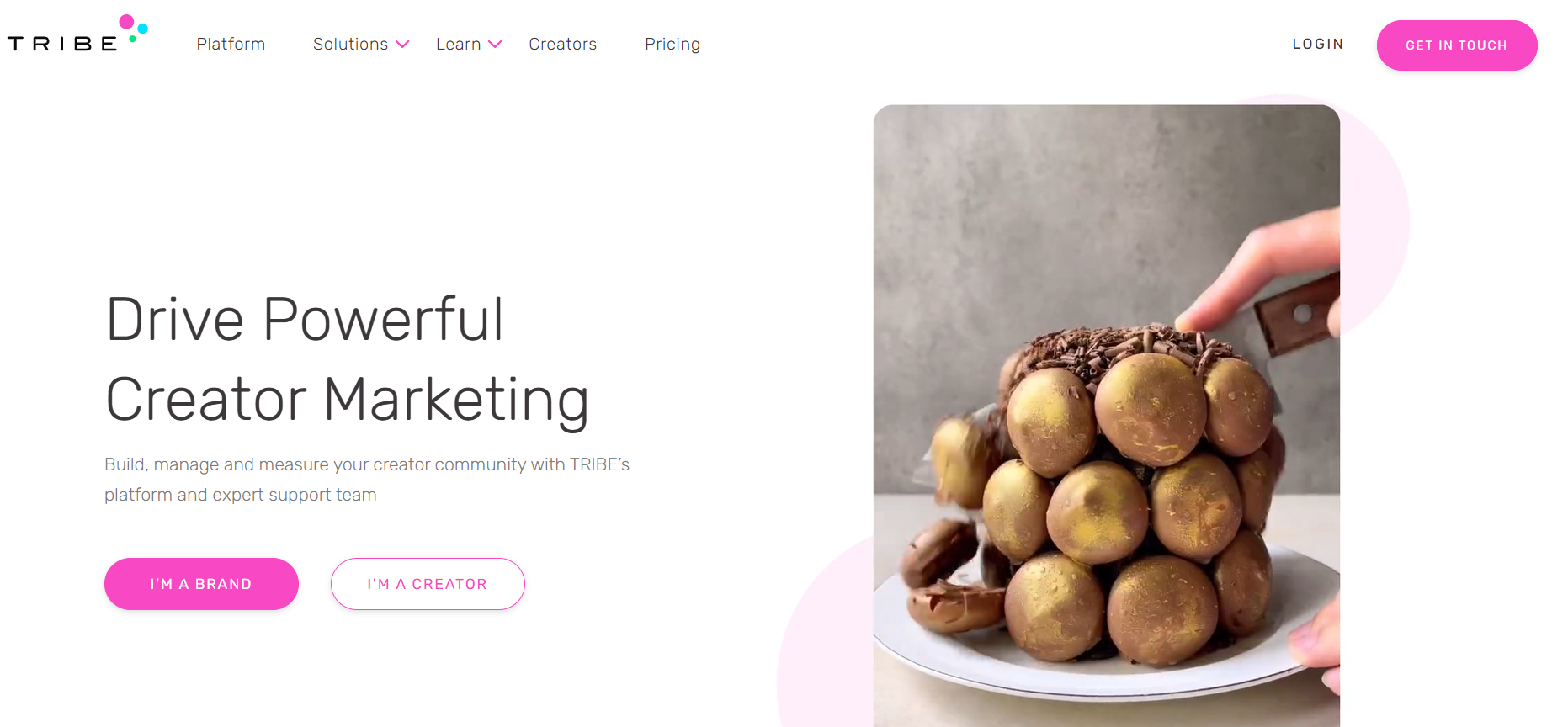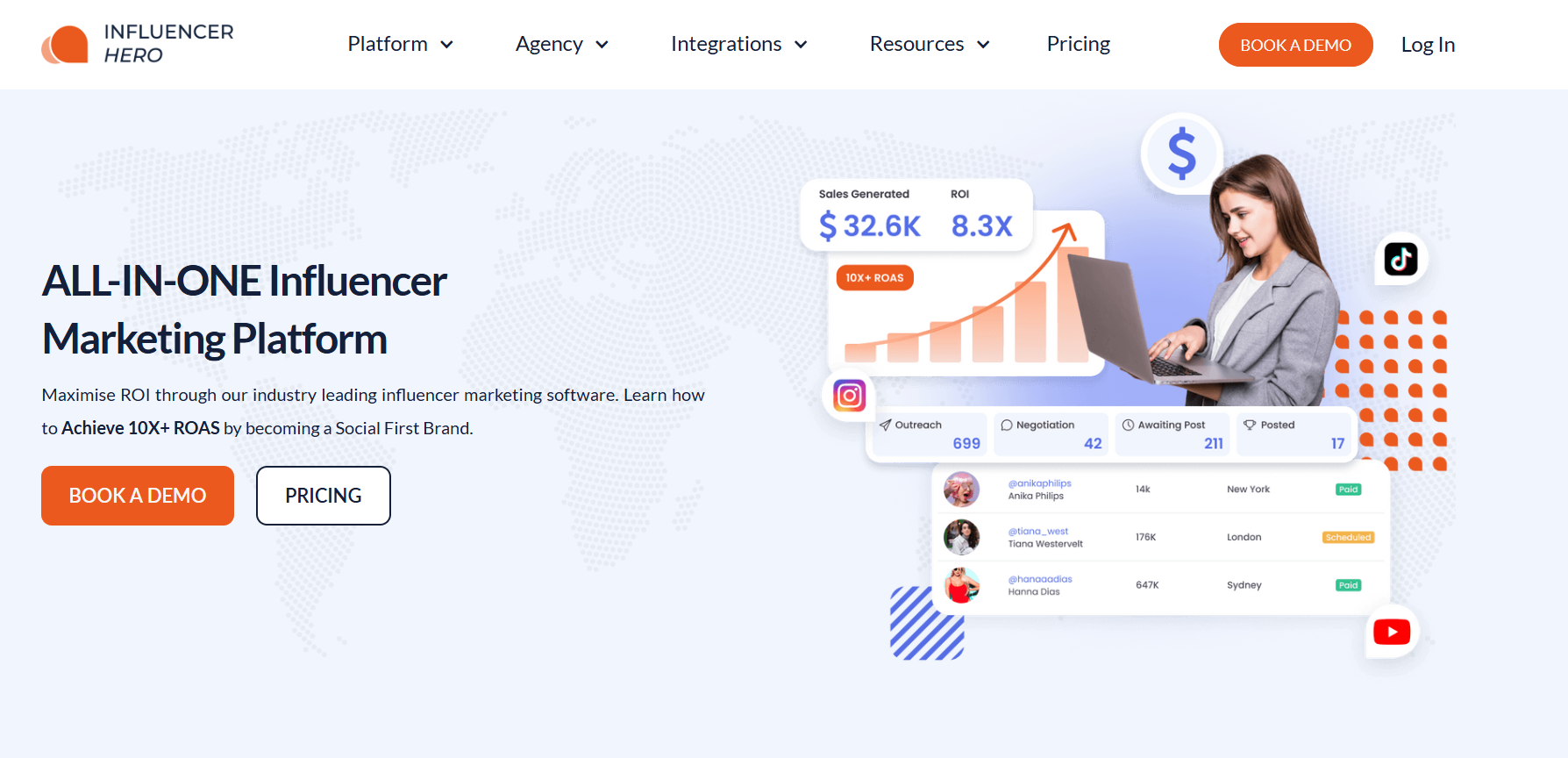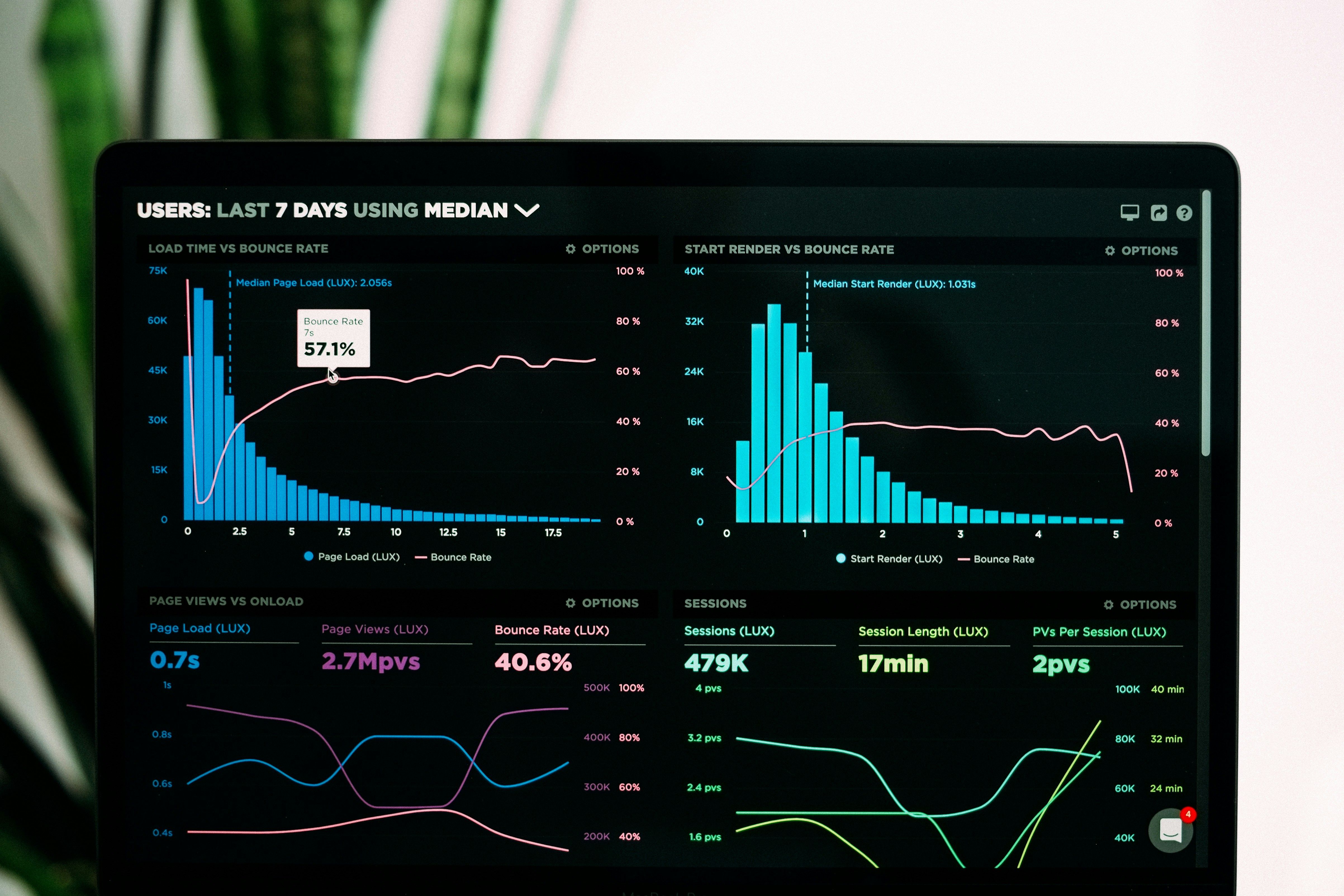Imagine that you don’t have to keep scrolling, sending DMs on Instagram or TikTok, and crossing your fingers that an influencer replies to your campaign.
If this sounds like a dream come true, an influencer database may answer your problems.
If you’re not familiar with influencer databases, think of them as an influencer directory. Most databases have records of social media personalities with followings above a particular number on particular platforms–for example, an Instagram influencer database might have a record of tons of Instagram influencers with more than 5,000 followers.
But, finding the right social media influencer database for your brand can be tricky–so many are on the market, each claiming to be the best.
And influencer marketing is a huge industry–ad spending on influencers is forecasted to reach 39.3 BILLION dollars this year. In the US, influencer marketing is still growing, even with the government threatening to ban TikTok at the end of last year.
So, that leaves us with the obvious question: How do you pick the best influencer database for 2025?
To answer that question, we’ll discuss what to consider when choosing a database of influencers–and review the top ones in 2025. We’ve also included a brief action plan to help YOU find the best influencer marketing database for you.
What factors should you consider when picking an influencer database?
The top influencer databases have a few things in common. Before we assess the strengths and weaknesses of each platform, let’s talk through what you need to consider before subscribing to a social media influencer database.
Pricing
Fair warning– influencer databases can be expensive. Before you pick your favorite platform:
- Check their pricing page
- See how much it costs per month
- Find out if they require a time commitment or contract. After all, you don’t want to be stuck in a contract if things don’t work out.
Oh, and if their pricing page is hidden, stay away. A hard-to-find pricing page means they’re SUPER expensive.
Influencer data
When you’re going to hire influencers, you need to know how their posts perform. If you want to use an influencer directory to find them, start with this question:
Does the influencer database include metrics for their influencers?
If not, look elsewhere. After all, how will you know if their content works if you can’t see their stats?
You need to ask the second– and equally important– question: How does the database get these metrics?
If the influencer platform gets its metrics from integration with Meta or another social media platform, that’s the best. If it’s via public data, that isn’t as accurate.
From there, you’ll also need to consider the specific types of data you’ll need access to. This will depend on your campaign goals, but here are a few that often come in handy:
- Engagement: Engagement rate is SUPER important. Influencers with more engaged audiences make more of a difference for your brand. Generally speaking, you can expect micro-influencers to have better engagement rates than their macro-influencer and celebrity counterparts.
- Location: If you occasionally need to know how to find local influencers, make sure you can filter by location. Bonus points if you can ALSO filter by audience location.
- Niche: You’ll need to be able to find influencers by niche. If you hire an influencer who doesn’t work in your niche, their audience won’t care about your brand.
- Followers: If you’re wondering how to find micro-influencers on a database, the easiest way is to be able to sort them by number of followers.
- Accepted payments: If you’re hoping to do influencer gifting, finding influencers who will collaborate in exchange for free stuff is invaluable.
Influencer profiles
You’ll want to be able to check influencer profiles before working with them. Here are some features you’ll want to look for on the influencer platform:
- Public reviews: What do past collaborators (brands) have to say about these influencers?
- Portfolio: What do their past projects look like? What’s the quality of their work?
- Audience insights: Where is their audience from? How many age groups do they have? What do their gender demographics look like?
- Platform: Most databases include Instagram and TikTok influencers, and some include YouTube. If you’re looking to build your brand on a specific platform, make sure you can tell at a glance which one the influencer uses.
Influencer opt-in (or not)
There are two main types of influencer databases on the market:
In one, influencers opt-in to the service, meaning they sign up and go through an approval process.
These generally make it easy to connect with influencers and offer contract and payment protection options. If influencers sync their accounts directly to the influencer platform (like on Social Cat), they also have accurate metrics. So, if you’re looking for an easy way to contact and hire influencers, you may want to look for this kind of product or database.
In the second type of influencer database, influencers don’t opt into the platform. These databases or products simply import influencer profiles from social media and build their database that way.
Having this information in one place can save you a lot of time (and allow you to find details on almost any influencer!), but their data can be outdated. Also, you’ll have to cold email any influencers you see on a non-opt-in platform and hope they respond, which is always risky.
Collaboration types
As you head into an influencer campaign, you likely have some ideas about how you want to run it.
To make sure you can find influencers who will be willing to work with you, you need access to the following information:
- Do influencers do paid collaborations only?
- How much do they charge for paid collaborations?
- Do they do gifted collaborations?
- Does the platform provide contracts so we can iron out all these details and get them in writing?
When you’re just getting started, it helps to research examples of successful influencer campaign stories. That way, you can see what’s worked for other brands and use those insights when promoting your brand.
Goals
The platform you choose also depends on your campaign goals.
If you’re looking for UGC (user-generated content): If you need to find UGC creators, your path is clear. You need a platform to find influencers, ideally one that includes a portfolio maker to showcase their work professionally. Looking at UGC video examples from different creators can tell you who can give you the content you want.
If you want to create brand awareness: You need a platform that shows metrics for reach and sign-up impressions.
If you’re mainly interested in sales: You need a platform that shows metrics, particularly on audience insights, to determine if their audience matches your customer avatar.
What are the best social media influencer databases to use in 2025?
Now that we’ve discussed what to look for in a platform, let’s cover the best influencer databases to work with in 2025. It’s worth noting that you usually have to pay for quality. A free influencer database isn’t usually worth much. You’re better off paying a little bit to get the content you need, rather than trying to find a free influencer marketing database.
Social Cat
Social Cat makes finding and working with influencers a breeze with an extensive network of influencers. On the Social Cat platform, you’ll find vetted influencers with the metrics, search, and collaboration options you need to create an amazing influencer-driven campaign.

Advantages
- Affordable: Social Cat has no contracts, a cancel-at-any-time policy, and competitive influencer platform pricing.
- Vetted influencers: Influencers opt-in (sign up) themselves, which means our team vets them. We don't simply import profiles.
- Large talent pool: There are over 50K influencers on Social Cat!
- Real-time metrics: Metrics and audience insights come directly via integration with Meta (for our Instagram influencers database) and TikTok (for our TikTok influencers). So you can trust the influencer stats in our database are always up-to-date.
- Collaboration options: You can do both gifted and paid collaborations on Social Cat– and contracts are available for each.
- Messaging: You can communicate directly with influencers via our platform. No cold emailing or DMs on Instagram like it’s 2010. Welcome to 2025!
- Search: You can browse and filter through our database to invite influencers to campaigns.
- Licensing: Content licensing is included in all the influencers’ pricing, so you don’t have to worry about surprise fees down the road.
Disadvantages
- Limited platforms: TikTok and Instagram are the only platforms available.
- Limited countries: You can only work with influencers in the US, UK, Australia, and Canada.
- Influencer fees not included: Fees for paid collaborations are not included, but you know how much an influencer wants to charge you, so that's easy. You can also opt-in for gifted collaborations, which don’t cost extra.
Social Cat is designed to be easy to test out, with free trials, expert onboarding calls, and no contracts, so you have the confidence to find the right brand influencers every time. That’s probably why the reviews are so great, with nearly 2,000 users rating them an average of 4.7 stars. Sign up as a brand to start a free trial today.
Modash
Modash is a metrics-only database. That means that you can find deets on any influencer or creator with over 1,000 followers on Modash – you just have to reach out to them on your own if you want to work with them.

Advantages
- So. Much. Data: Modash has over 250 MILLION profiles of influencers for you to search. Remember that these influencers have not opted in or given information to Modash, so you’ll essentially be cold-emailing them. However, having that amount of information can be very helpful.
- Influencer metrics: They have influencer metrics available for each of their profiles. Please note that these metrics come from public data so they might be inaccurate.
- Contact details: They have influencer contact details available on their platform. Again, these come from publicly available data, so we’re unsure how accurate they are.
Disadvantages
- Pricing: Their lowest-tiered plan starts at $299/month.
- Not vetted: Their influencer profiles are imported from social media, so no one vets these influencers. You have to look at the profile, reach out via the contact information provided, and hope for the best.
- Expense creep: You don’t have unlimited access to all their features at lower prices. You'll pay more if you want to take full advantage of their services.
- No messaging: Because influencers don’t “opt-in” to Modash, there’s no way to connect directly with influencers on the platform. You must export email addresses (a limited number each month) and see if they’ll work with you.
- Influencer pricing not available: Because all of their information is sourced from public data, you have no way of knowing what influencers charge before reaching out to them.
- Contracts not included: There are no contracts available on their platform.
- Licensing: Content licensing is not included in Modash's pricing because they aren’t affiliated with any creators on their platform.
Modash empowers you to look up any influencer you’d like, but that’s about it. If you opt for a less-expensive plan, you may be frustrated by the limits set on influencer profile views, contact information, and more–although they have raised their prices to accommodate some of these concerns. Also, you must cold-email creators yourself, which adds time and effort to your campaigns.
Grin
Grin describes itself as a “creator management platform,” which means they have resources to help you discover influencers and keep yourself organized as you create and review campaigns.
Like Modash, creators do not opt-in to Grin, meaning there is no vetting process in place for them.

Advantages
- Tools: Grin has tons of tools to help you create and manage influencer campaigns. Plus, they integrate with other marketing software to make recordkeeping and data importing as smooth as possible.
- Database: Millions of influencer profiles are available to browse..
- Influencer types: They have data on different types of influencers, including nanoinfluencers, microinfluencers, and macro-influencers.
- Platforms: Grin covers multiple platforms, including TikTok, Instagram, YouTube, and more!
- Support: There are good support options available for paying customers.
Disadvantages
- Pricing: Their pricing is only available upon request, which means it’ll be expensive. You need to book a demo with a salesperson to get a price, who will likely try to see how much they can charge you.
- Not vetted: Influencers do not opt into this platform, so there’s no vetting.
- No messaging: Again, because influencers do not opt into this platform, you need to email them and hope they respond.
- Potentially inaccurate data: Their metrics and other data come from public sources, which may be incorrect.
- Geared for super-premium customers: They focus on attracting high-end clients with thousands of dollars per month to spend on influencer campaigns. Their prices and functionality aren’t ideal for small and mid-sized companies.
- Influencer pricing/contracts not included: Because they are not affiliated with any influencers in their database, you will need to pay them on top of what you’re already paying for access to Grin.
- Licensing: Because they are not affiliated with any of the creators listed in their database, licensing is not included in their pricing.
Grin offers fantastic products and services– however, they’re geared toward super-premium customers who spend thousands of dollars on influencers. Unless you need their suite of tools, there’s no significant difference between what’s available in their database and Modash’s.
Tribe
Tribe calls itself a “creator community.” They have a ton of features that make creating and executing an influencer campaign easier, including opted-in creators, accurate metrics, and communication via their platform.

Advantages
- Opted-in influencers: They have over 70K opted-in influencers on their platform, which makes connecting with and hiring influencers a breeze.
- Accurate metrics: They provide post-campaign data directly from social media platforms. Get accurate ROI measurements every time!
- Expert team: They have an expert (albeit expensive) team that’s available to help you tailor your campaigns.
- AI tools: Their AI tools can help you match your brand with influencers.
- Launch campaigns: If you need help launching your campaign, they have resources for that!
Disadvantages
- Expensive: There’s no price listed on their website, which, as always, usually means it’s expensive. They also use annual agreements, so you’re locked in for a year. If you’d like to avoid signing a contract, they have a “pay per use” option but then charge other fees like activation fees to raise the cost.
- Licensing: Even though their creators have opted into the platform, licensing is a separate cost, which makes the content you get on Tribe even more expensive.
- Influencer fees: We couldn’t find any data on how much influencers charge, but their fees would also be on top of Tribe’s other costs and fees.
Tribe checks all the boxes we like to see on influencer platforms: opted-in influencers, metrics that come directly from social media integrations, and campaign support options. The only problem is that you’re locked into SO MANY fees, year-long contracts, and unspecified prices just to get access to their network. It’s good but unnecessarily more expensive than other options on the market.
Collabstr
Collabstr’s home page looks like you landed on the Airbnb website– for booking influencers. This influencer-centric approach means you get LOTS of information about the influencers themselves–but less about everything else.

Advantages
- Vetted influencers: All of their influencers are vetted, and their platform has a review system so that you can hear about other brands’ experiences working with them.
- Messaging: You can directly message creators on the platform. Yay!
- Multiple platforms: They have influencers who create content on TikTok, Instagram, and YouTube.
- Payment protection: There’s a payment protection system included, so you don’t have to worry about losing money and not getting content.
- Free trial: They allow you to “start for free” before you commit to using the platform.
Disadvantages
- Price: While you can view project prices for specific influencers (many of which are thousands of dollars each), it’s unclear how much it costs to get access to Collabstr and whether or not they require a contract.
- Database size: Again, it’s unclear exactly how many influencers you have access to when you join Collabstr.
- Licensing: Licensing isn’t mentioned anywhere on their website, so you may have to pay extra to use the content their creators make for you.
- Metrics: As far as we can tell, no metrics are available for the creators on Collabstr– they simply post their projects and a price, and you have to look at reviews to decide if you want to hire them.
While Collabstr is visually appealing and has some good features, the pricing is murky. If you’re considering joining, it might be worth reaching out to their team first to chat about pricing and licensing and to ask if you must sign a contract to access their platform.
Influencer Hero
Influencer Hero is an all-in-one influencer marketing CRM, where you can streamline every step of your influencer campaign. From influencer search and automated outreach to post tracking and affiliate programs, Influencer Hero allows for full management in one place.

Advantages:
- Detailed filters: Since Influencer Hero has a huge database of influencers across different social media platforms and all around the world, it offers multiple detailed filters to narrow down your search both on the influencer level as well as the audience level.
- Automated tasks + AI Tools: Although influencers don’t opt-in, you can automate influencer outreach with email drip campaigns, including follow-ups. Also, their AI integrations allow for a highly effective personalized sentence for each influencer.
- Complete CRM: Influencer Hero offers all the tools you need when managing an influencer campaign. Their Trello-like board keeps everything organized. Each influencer has a deal page for all information, including posting performance, creative assets, and communication.
- Content/UGC Library: If you want to share influencer content on your social media or create paid ads with UGC content, you can quickly download these from Influencer Hero’s content library.
- Shopify integration: With this integration, you can directly dispatch products to influencers, track the shipping, and create affiliate links and discount codes to track the influencer’s performance.
- Robust reporting capabilities: Influencer Hero provides detailed individual and campaign-level reporting and analytics. Their reports include KPIs like clicks, conversions, and earned media value. You can view country-specific click data, outreach statistics, and top-performing influencers.
- Let them do the work for you: Agency services are also an option with Influencer Hero, where they can manage your entire influencer campaign for you!
Disadvantages
- Influencer pricing not available: Unfortunately, there is no way of knowing what influencers charge before reaching out to them. Using the negotiation templates that Influencer Hero provides can help to increase ROI.
- Licensing: Content licensing is not included and must be negotiated with each influencer.
- Contracts: Influencer Hero currently does not offer a built-in contract signing system. The contract will have to be managed through email.
Lefty
Lefty uses the combo of influencer data & sophisticated analytics tools to help bring the numbers to life. If you’re a data-driven marketer, you’re going to love the way they present insights on influencers. Just be aware: they are a premium product, with prices to match.

Advantages
- Excellent filters: Their search functionality allows you to filter your results by things like engagement rate and keywords–two metrics that aren’t always included on other platforms.
- Wide range of social media platforms: Lefty services Instagram, TikTok, X/Twitter, YouTube, Weibo, Douyin, and Red.
- Influencer fee estimator: They’ve created a cool tool to help you estimate the fees that a particular influencer might charge, based on the package you’re looking for.
- Lookalike tool: You can use another tool to find influencers in your niche with similar engagement rates, audience demographics, and more.
- Advanced influencer tools: Their casting lists allow you to collaborate with your team on what influencers you’d like to “cast” in certain campaign roles. Their influencer forecasting tool allows you to predict how an influencer’s engagement will grow over time.
Disadvantages
- No on-platform messaging: Influencers do NOT opt-in to Lefty. It is a true influencer database. You will have to reach out to them outside of the platform.
- Licensing: Licensing is not included in their pricing–you’ll have to negotiate that with each influencer, too.
- Influencer fees: Although they can help you estimate what an influencer might charge, you still have to negotiate rates for any collaborations, and pay those influencer fees on top of the pierce you’re already paying for Lefty.
- No vetting: You can refine your search by things like engagement rate, but Lefty doesn’t filter out any influencers before you do that.
- Pricing: Again, you have to book a demo–which means it’s going to be PRICEY.
There are definitely reasons to use Lefty. It’s an influencer database with a slew of social media influencer data and some great tools to help you use it. However, there are a lot of tools that you simply don’t need as a small to medium-sized business. They’re also quite focused on brands that want to hire mega-influencer and celebrities, which isn’t the best investment for most brands.
Captiv8
Captiv8 is a management-centered influencer database So yes, they have discovery tools–but their real selling point is that they can service your entire program, all in one place. If simplicity is what you crave, then Captiv8 might appeal to you.

Advantages:
- 500 search filters: You can refine your influencer search in any way you’d like.
- Influencer analytics: They have analytics attached to each influencer to help you make decisions.
- TikTok integration: They integrate with TikTok, ensuring that many of their TikTok influencers' stats are up-to-date.
- Minority-owned: Captiv8 is minority-owned and committed to DEI, which is always a good sign if you’re hoping to reach minority groups with your marketing.
- Data dashboard: They have a comprehensive data dashboard to help you track your campaigns.
- Measurement: They’ll help you measure and understand the performance of your influencer marketing campaigns.
Disadvantages:
- They aren’t primarily an influencer search platform: If you need help with influencer search, paying extra for a database that isn’t the company's sole focus is not ideal.
- Influencer outreach: Influencers do not opt in to Captiv8, so you’ll have to nurture those relationships yourself.
- Pricing: No price is listed on their platform. You must book a demo. By now, you know the drill: that means they’re EXPENSIVE!
- Licensing: Licensing for influencer content is not included in the price of this platform.
- Meta integration: They don’t appear to integrate with Meta, which means their Instagram influencer database may not be accurate.
- Added complexity: This platform has a LOT of features that you probably don’t need if you’re simply looking for a website to find influencers.
Captiv8 is an excellent option if you want to view all your influencer analytics in one place. However, it has no extra search features to offset the price. As far as being a content creator database goes, it might not be the best value for the price.
Conclusion
The best influencer database for you will be determined by your budget, which features you need, and how long you can commit to working with a specific influencer directory. The top influencer databases in this article are great choices.
Here’s our advice on how to make the best decision: organize demo calls, explore what you can on a free trial, and stay away from longer time commitments to a specific TikTok or Instagram influencer database.
Remember: a higher price does not guarantee a higher ROI. So, it’s worth checking out use cases, too. The right influencer marketing database will have a low enough price that you can actually see returns.
We won’t sugar-coat it: working with influencers can be challenging, especially at first. Generally, it takes tens or hundreds of collaborations to find people who effectively generate sales for your brand.
Because it can be such an involved process, you’ll ideally want to use a platform that has lower fees and does gifted collaborations so you can figure out what works best for you without going bankrupt. After that, if you want to add a more expensive database of influencers to your arsenal, you can.
Book a free demo with us if you’re ready to start your influencer marketing journey. We look forward to meeting you!
Table of content
Looking for influencers?










